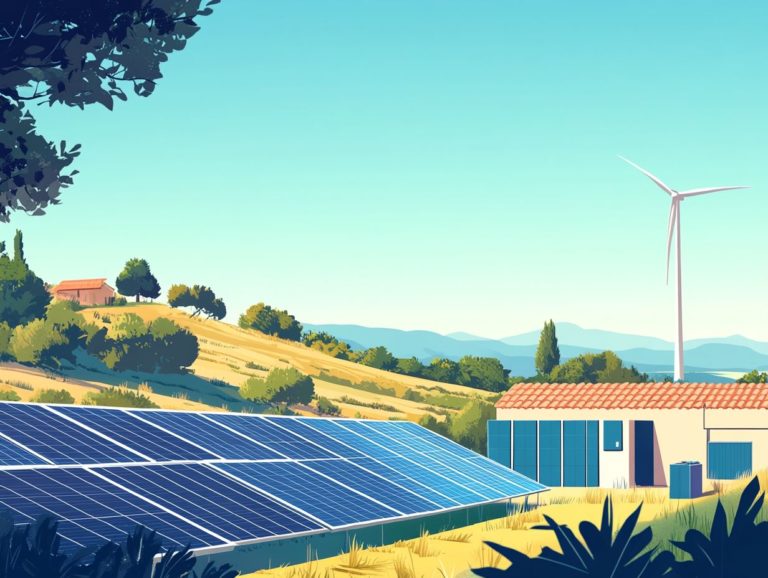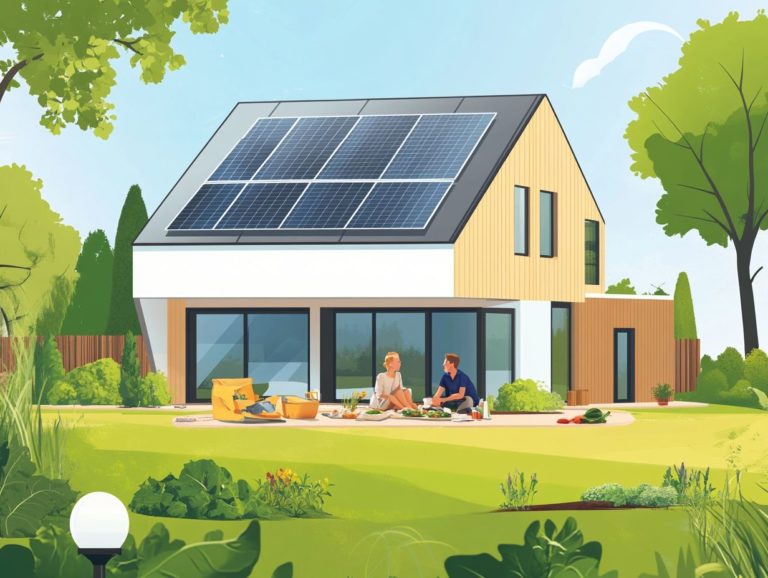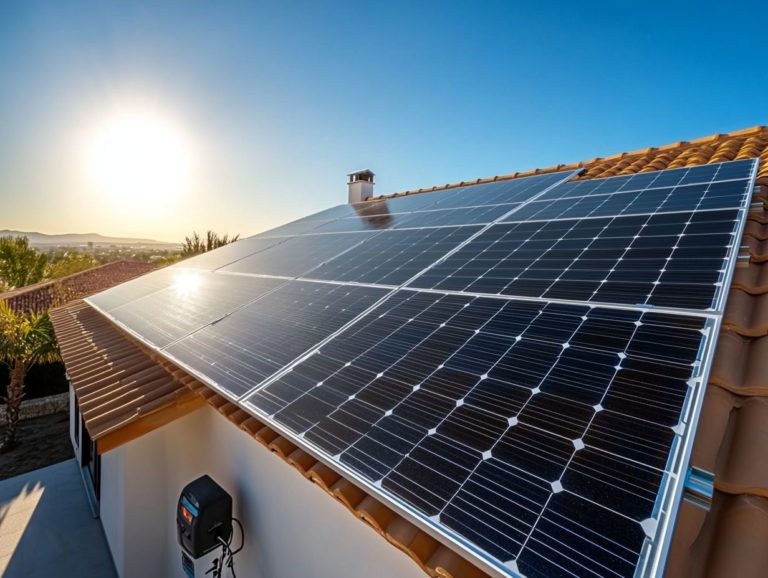“Exploring Hybrid Solar Systems for Your Home”
Hybrid solar systems are revolutionizing energy use in homes. They blend traditional solar setups with versatile battery storage.
Get ready to discover the amazing benefits these systems offer! They enhance efficiency, save costs, and positively impact the environment.
You ll explore various types of hybrid systems, essential components like solar panels and inverters, and key installation and maintenance steps.
Find out how hybrid solar solutions can empower your energy independence and boost your home’s sustainability!
Contents
Key Takeaways:
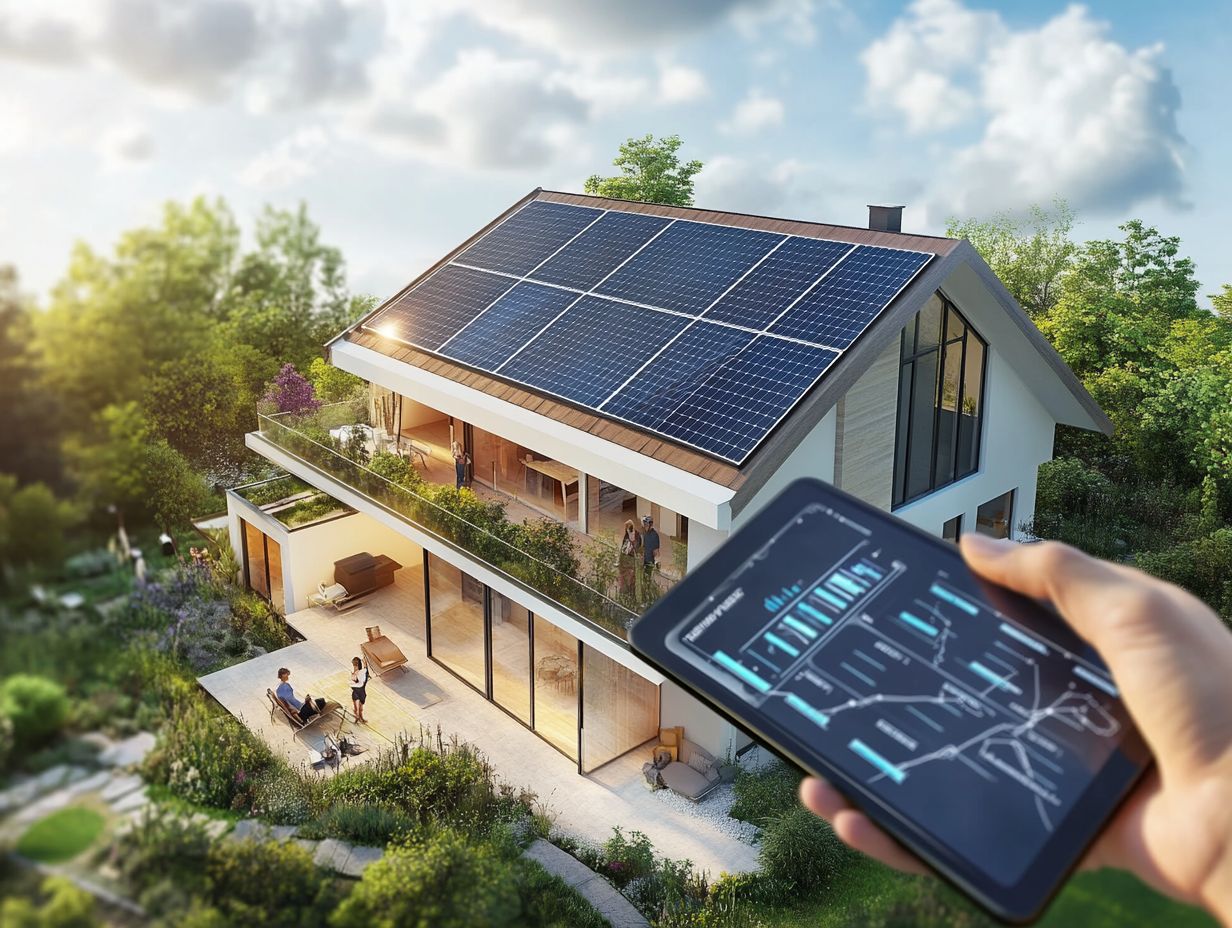
Hybrid solar systems combine grid-tied and off-grid benefits, making them a cost-effective option for homeowners.
By using solar energy, they lower electricity bills and reduce carbon emissions.
The main components include solar panels, batteries, and inverters, all working together to store energy efficiently.
What are Hybrid Solar Systems?
Hybrid solar systems are advanced solutions that integrate multiple energy technologies. They allow you to harness solar power and manage energy with battery storage.
These systems combine traditional solar setups with battery banks for energy independence. They help you stay resilient against power outages.
A hybrid solar system includes:
- Solar panels that convert sunlight into electricity.
- A hybrid inverter that manages energy flow.
- Battery storage units that hold excess energy for nighttime or cloudy days.
By combining these components, hybrid systems enhance your household’s solar energy use and provide a stable electricity supply.
This synergy leads to lower energy bills and greater control over your power usage. It’s a step toward a more sustainable living environment.
Benefits of Hybrid Solar Systems
Hybrid solar systems offer remarkable energy savings and resilience during power outages. They also provide opportunities for valuable solar tax credits.
This makes them a smart investment for homeowners eager to effectively harness renewable energy.
Efficiency and Cost Savings
The standout benefit of hybrid solar systems is their efficiency, leading to significant savings on electricity bills. You can benefit from net metering and optimized energy output from solar panels.
These systems combine traditional energy sources with solar power. You can use solar energy while tapping into grid energy when necessary.
With advanced energy management techniques, you can adjust your usage based on real-time data. This ensures you maximize solar energy availability.
Studies show households using hybrid systems can cut energy costs by up to 50%. Through net metering, you can sell excess energy back to the grid, giving you more financial benefits.
A California case study revealed that homeowners saved about $1,200 annually, showcasing the benefits of hybrid technology.
Environmental Impact
Hybrid solar systems minimize your environmental footprint while promoting renewable energy use. By switching, you can significantly cut your carbon footprint.
Using solar and traditional energy sources reduces fossil fuel reliance, improving air and water quality. This choice supports cleaner air and aligns with sustainability-focused energy policies.
As you and your community adopt hybrid systems, you contribute to reducing greenhouse gas emissions. This proactive choice helps combat climate change and highlights the power of renewable energy for a healthier planet.
Types of Hybrid Solar Systems
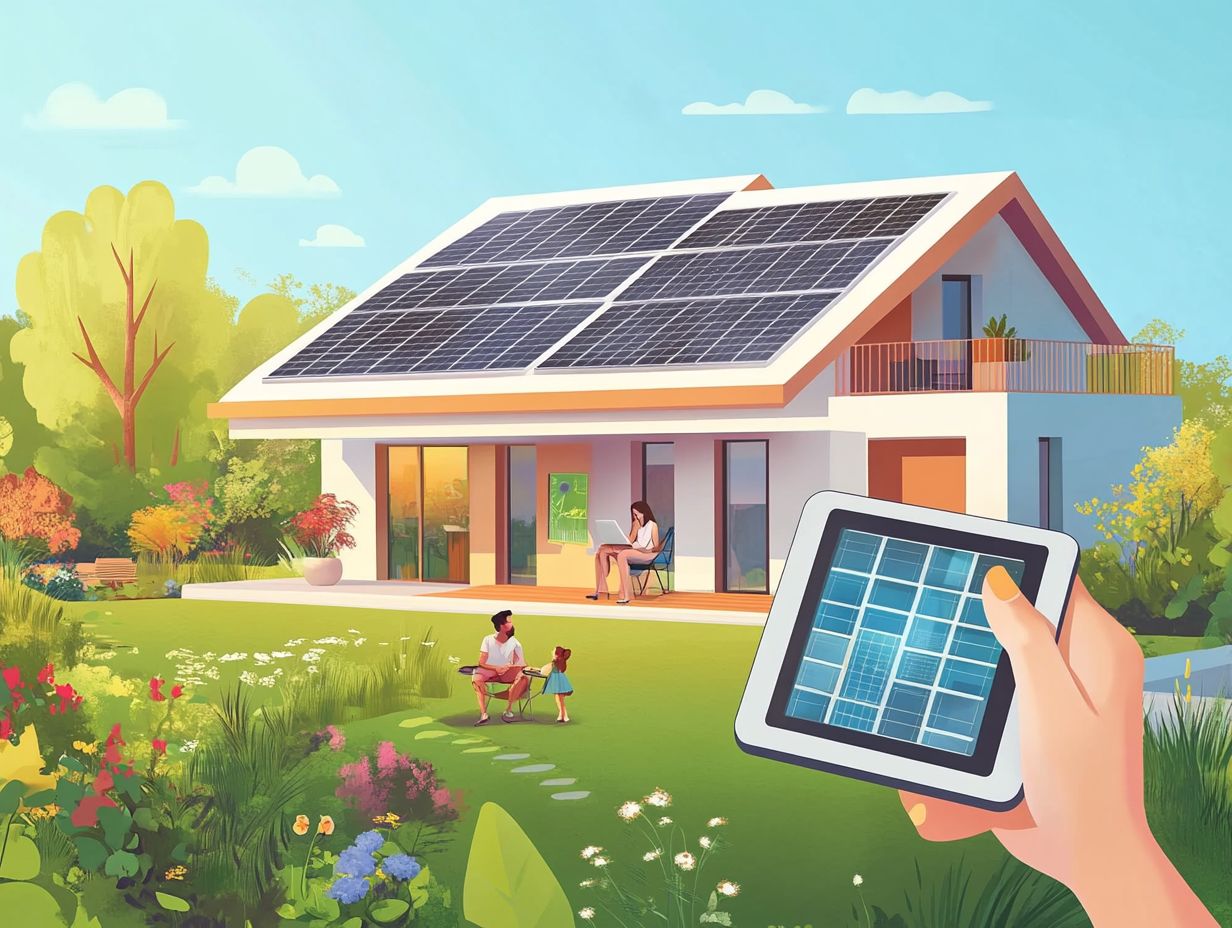
You ll encounter two main types of hybrid solar systems:
- Grid-tied systems that seamlessly connect to the utility grid, allowing for a smooth flow of energy.
- Off-grid systems that grant you complete energy independence by relying exclusively on battery storage and solar panels.
Grid-Tied Systems
Grid-tied hybrid solar systems are crafted to connect to the utility grid, giving you the power to harness solar energy and use it directly. You can also take advantage of net metering to reduce your electricity bills and enjoy substantial savings.
These systems not only provide access to renewable energy but also allow for efficient energy flow, maximizing your savings even during less sunny periods.
By connecting to the grid, you can rely on utility power whenever your solar panels aren t producing enough energy. You ll never have to worry about a power shortage.
When you re ready to install, it s wise to gather multiple quotes to ensure you’re getting competitive pricing and top-notch installation quality.
Monitoring your energy consumption is easy, allowing you to fine-tune your usage patterns and boost your long-term savings and sustainability efforts.
Off-Grid Systems
Off-grid hybrid solar systems grant you complete energy independence by harnessing solar panels and battery storage, all without reliance on the utility grid. This makes them perfect for remote locations or for those who crave maximum energy resilience.
These systems include several essential components, such as charge controllers that regulate the voltage and current from the solar panels. This ensures your batteries charge optimally.
By tapping into solar energy, you can significantly cut down on your dependence on external energy sources, leading to a more sustainable and self-sufficient life.
Energy independence offers many advantages, such as cost savings and a commitment to environmental stewardship. However, it does come with its own set of challenges. Installation requires meticulous planning and a solid understanding of local conditions, along with ongoing maintenance to keep everything running smoothly over time.
Balancing these elements is key to enjoying a successful off-grid experience.
Components of Hybrid Solar Systems
The essential components of hybrid solar systems consist of solar panels, batteries, hybrid inverters, and energy storage solutions. Each element plays a pivotal role in capturing solar energy and ensuring a seamless flow and efficient management of that energy for your needs.
Solar Panels
Solar panels, often known as photovoltaic panels, are essential elements of hybrid solar systems. They transform sunlight into electricity, significantly enhancing solar efficiency for your residential energy needs.
Efficiency ratings can vary considerably based on the panel type, with monocrystalline panels typically leading in performance due to their high silicon purity. You also have the option of polycrystalline and thin-film panels, each presenting unique advantages and disadvantages that cater to various requirements and budgets.
The installation method you choose is crucial, as roof-mounted systems differ from ground-mounted ones not just in cost, but also in their energy output potential. Recent advancements, like bifacial panels that capture sunlight from both sides, further elevate overall system performance.
This makes it essential to select the right panels thoughtfully to maximize energy generation and secure sustainable electricity solutions.
Hybrid Inverters
Hybrid inverters manage the flow of energy between solar panels and batteries, ensuring efficient energy use. They play a critical role in optimizing the performance of hybrid solar systems.
Batteries
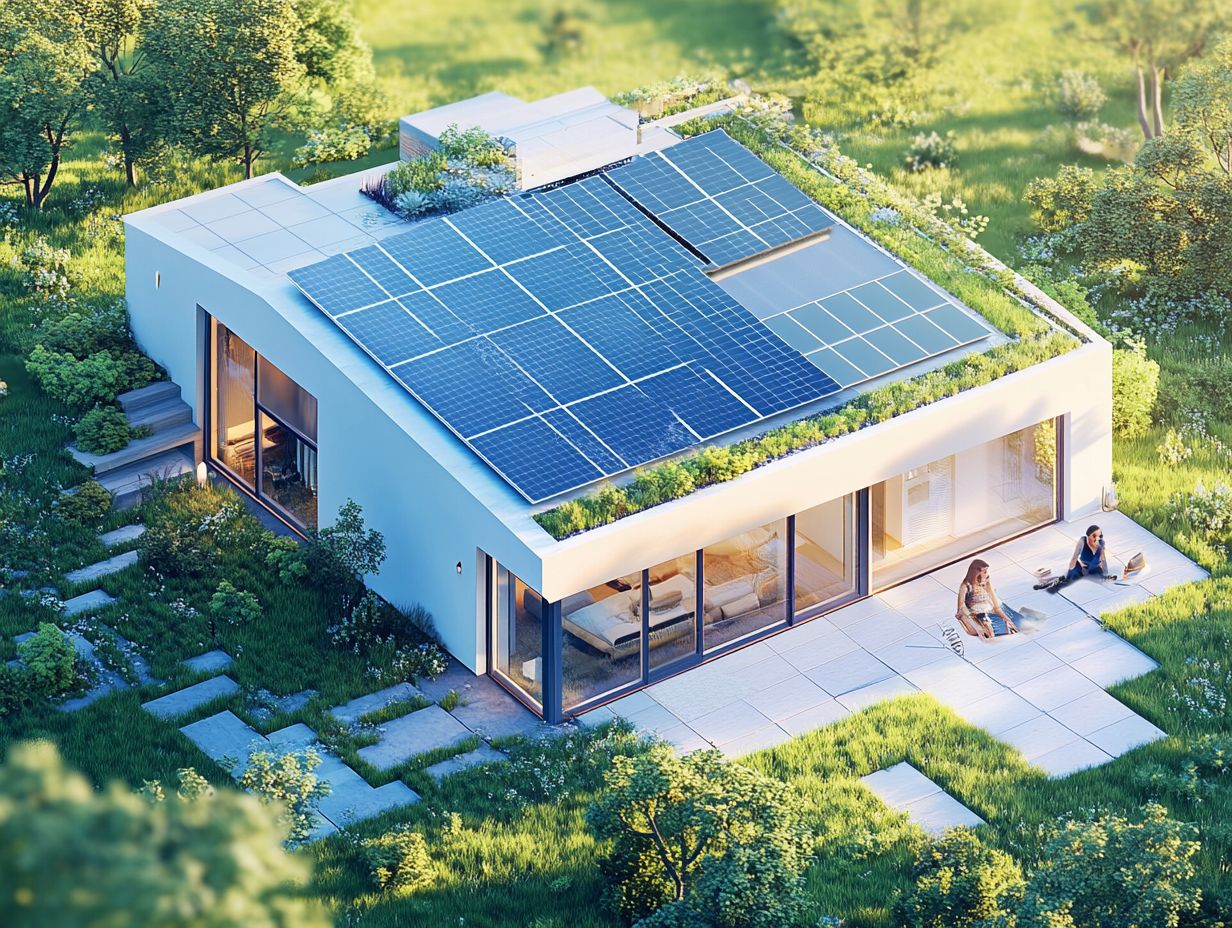
Batteries are crucial for energy storage in hybrid solar systems. They let you store extra solar energy collected during the day for use at night or during power outages.
Various battery types are available, including lead-acid, lithium-ion, and flow batteries. Lithium-ion batteries are popular due to their high energy density, efficiency, and longer lifespan.
Understanding battery capacity is important. It meets your energy demands during peak usage and prevents over-discharge, which can harm your battery.
Choosing the right battery size helps you manage energy effectively. You can also track your energy consumption patterns.
This oversight leads to better use of stored energy and significant cost savings.
Inverters
Hybrid solar inverters are essential components in hybrid solar systems. They convert the direct current produced by your solar panels into alternating current to power your home appliances. These devices improve energy conversion efficiency and allow smooth transitions between power sources.
Unlike traditional inverters, hybrid solar inverters offer enhanced flexibility. They store excess energy in batteries for future use, optimizing your overall energy management.
You can use stored solar energy even on cloudy days, reducing your electricity costs. The inverter you choose directly impacts your system’s performance a more efficient hybrid inverter means better energy retention and a lower carbon footprint.
Installation and Maintenance of Hybrid Solar Systems
Ready to switch to solar? Follow these steps for a smooth installation.
- Start by obtaining installation quotes to gauge your options.
- Then carefully select the components that best suit your needs.
- It s crucial to implement effective energy monitoring to maximize efficiency and performance.
Throughout this process, keep a clear understanding of the associated installation costs to ensure a smooth and informed transition to solar power.
Steps for Installation
The installation process for hybrid solar systems usually begins with gathering multiple installation quotes. This allows you to assess costs and choose a qualified contractor, setting the stage for a successful solar installation.
This initial step leads to a comprehensive site evaluation, where professionals assess your property’s solar potential and identify unique design considerations related to your environment.
After that, you’ll need to secure the necessary permits to comply with local regulations this is crucial to avoid any future setbacks. Implementing a way to track and control your energy use is essential for maximizing energy efficiency and optimizing performance.
By engaging skilled installers, you can ensure that every aspect, from integrating with existing electrical systems to fine-tuning components, is executed flawlessly, ultimately enhancing the system s performance and reliability.
Maintenance Tips
Regular maintenance is crucial for your hybrid solar system. This ensures it performs at its best and lasts for years to come. Key practices include routine energy monitoring and cleaning the solar panels to maximize efficiency.
Consider establishing a detailed cleaning schedule, ideally every few months, to clear away debris and dirt that could obstruct sunlight. This helps prevent hindrances in power generation. Keep an eye on your system by checking all components, including inverters (which convert solar energy) and batteries (which store energy), regularly. This allows you to spot potential issues before they escalate.
By monitoring your energy output, you’ll notice any dips in performance and maintain your system’s overall health. Consistently implementing these preventative measures significantly enhances your solar system’s efficiency, leading to longer battery life and reduced operational costs over time.
Frequently Asked Questions
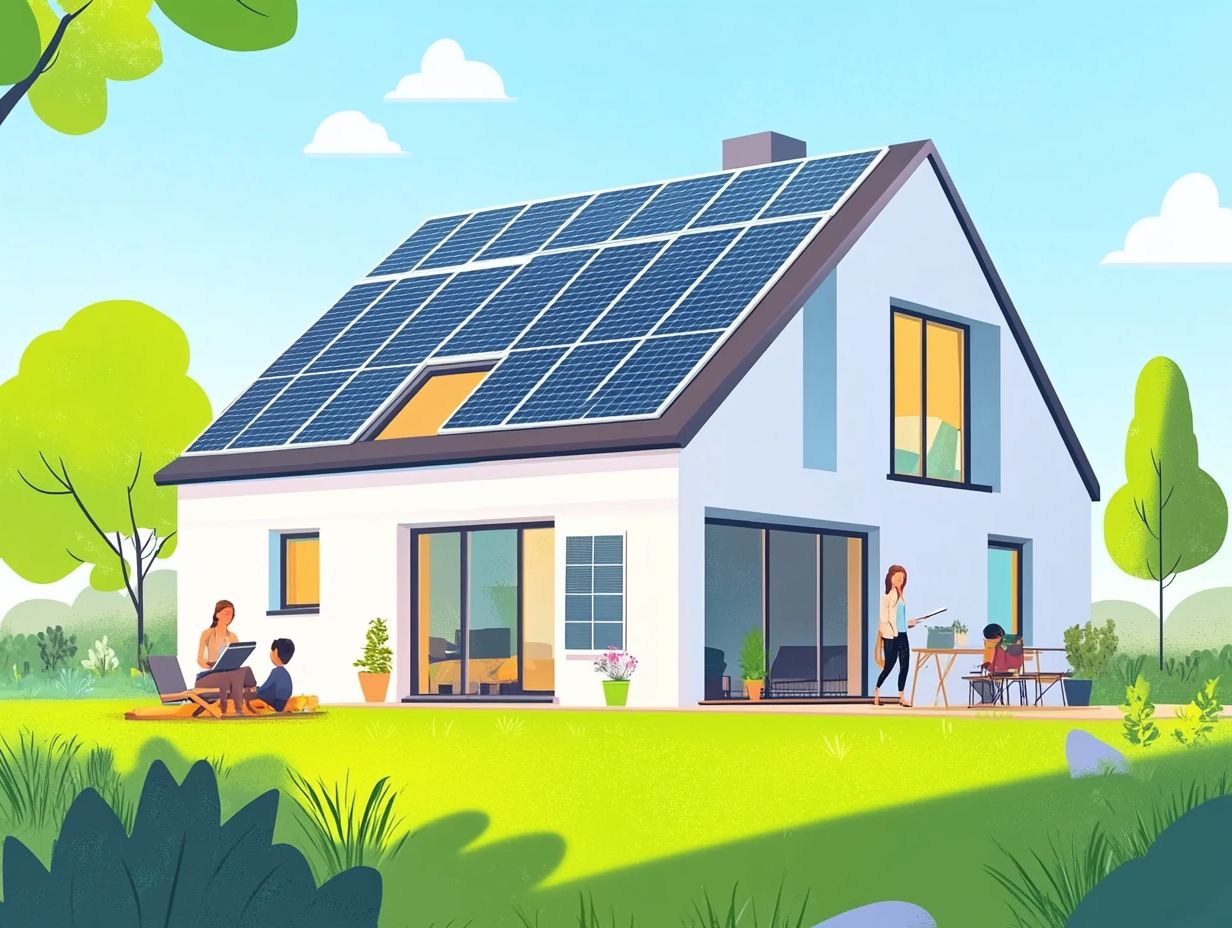
What is a hybrid solar system?
A hybrid solar system is a combination of traditional grid-tied solar panels and battery storage. This setup allows you to use solar energy during the day and store excess energy for use at night or during power outages.
How does a hybrid solar system work?
A hybrid solar system converts sunlight into electricity through solar panels. This electricity can be used immediately or stored in a battery for later use. The panels are also connected to the grid, allowing you to draw electricity when needed.
What are the benefits of a hybrid solar system?
- Reduced utility bills
- Increased energy independence
- Access to clean, renewable energy
- Battery backup provides peace of mind during power outages
Do I need a lot of sunlight for a hybrid solar system to work?
While sunlight is necessary for energy production, it’s not the only factor. The location and orientation of your home, along with the efficiency of your solar panels and battery storage, also influence energy generation. A reputable solar provider can help assess if your home is suitable for a hybrid solar system.
What is the cost of installing a hybrid solar system?
The cost of installation depends on factors such as system size, the type of solar panels and batteries chosen, and any additional equipment needed. It’s best to consult a reputable solar provider for an accurate quote. Remember, long-term savings on utility bills and potential tax incentives can offset the initial cost.
Can I add a hybrid solar system to an existing solar panel system?
Yes, you can add a hybrid system to an existing solar panel setup. This is often a cost-effective option for those already using solar panels. However, consult with a professional to ensure compatibility and proper installation.
If you re ready to explore hybrid solar solutions, contact a solar provider today!



